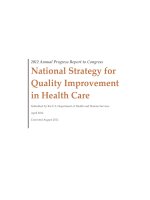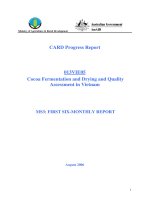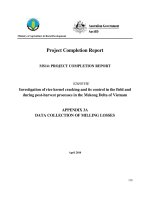Card Project Progress Report: " Cocoa fementation and drying and quality assessment in Vietnam " MS2 pot
Bạn đang xem bản rút gọn của tài liệu. Xem và tải ngay bản đầy đủ của tài liệu tại đây (36.52 KB, 6 trang )
1
CARD Project Progress Report
013/05VIE
Cocoa fementation and drying and
quality assessment in Vietnam
MS2: Cocoa Baseline Data
2
CARD Farmer Survey Ben Tre Province Summary August 2006 Refers to CARD Full Survey
spreadsheet
Of the 50 farmers surveyed in Ben Tre Province, they could be divided into four categories.
Category 1 exclusively fermented and dried their own cocoa. There were 4 farmers in category 1.
Category 2 farmers both sold pods and did their own fermentations when harvests were large enough. There
were 14 farmers in category 2.
Category 3 sold pods either to neighbours who had fermentaries, at breeding farms, at the fruit markets or to
buyers such E.D.&F Mann who have a fermentary as well as being a dry bean buying point. There were
twenty seven farmers in category 3.
Category 4 were farmers who were growing cocoa but not selling their produce yet. These farmers
presumably are using pods for seedling production. There were four farmers in this category.
All farmers, to some degree, use a proportion of their harvests to produce new seedlings.
1. Selling pods:
The prices received for pods varied from VND1500 to VND7000 per kilo. Some of the higher prices were
received (3000-5000VND/kg) were obtained by selling as fruit at local markets, or breeding farms, although
these prices usually apply to the largest and optimally ripe pods. The largest prices (VND7000) were received
from Vung Tau farmers. The most commonly encountered prices were in the vicinity of VND15000-18000 per
kilo with an overall average price of VND2363 per kilo, for those farmers surveyed. Most of the farmers
surveyed, who were selling pods did not store for long periods. This usually results in a conversion factor of
33% of wet bean weight to pod weight. Fermentation and drying is usually achieved at a conversion rate of
45% wet to dry bean ratio. Therefore 1 kg of pods would convert to 0.1485kg of fermented dried beans. This
means farmers who just sold pods received an average price of VND15912 per kilo of dry bean equivalent. At
the most commonly encountered prices the farmers would have received VND10100 to 12121 per kilo dry
bean equivalent.
2. Selling fermented dried beans:
The only major buyer in Ben Tre is ED&F Man Co. Prices received for dried beans varied from VND12000 to
VND24500 per kilo. The price of VND12000 only applied to one farmer, who presumably had quality problems.
Leaving this one farmer out, prices ranged from VND19000 to 24500. The average price received for this
cocoa was VND22000 per kilo, demonstrating a doubling of income over the most commonly received prices
for dry bean equivalents from pod selling.
3. Area of land planted and number of trees
(a) Category 1; Farmers fermenting their own cocoa
In the report file, the farmers fermenting their own cocoa have ID numbers 2, 4, 14, 28 and 40. Names and
district/village is given in the file. Number 2 is omitted from the figures as it is ED&F Man which is a buying
point for both fermented, dried cocoa and pods. It is not a typical village situation. The other farmers have
areas under cultivation of cocoa of 0.5, 0.7, 0.8 and 0.9 ha respectively, giving an average area of cultivation
of 0.725 ha. The average total area of these farms is 0.825 ha. Therefore 88% of their land is used for cocoa
growing with associated intercropping and the remainder for other crops.
Number of trees planted is 600, 800, 600 and 700 respectively. For these farms plantings were conducted in
either 2002 or 2003, except for farmer 40 who planted 150 trees in 2004 and 250 in 2005. Therefore the
average number of trees for farmers fermenting and drying their own cocoa is 675 trees.
(b) Category 2: Farmers both selling pods and fermenting and drying during peak harvest.
3
There are fourteen farmers in this category. In the excel file these farmers are ID numbers; 20, 21, 22, 23, 25,
27, 29, 30, 31, 32, 33, 34, 38 and 42. These farmers have areas under cultivation of cocoa of 0.9, 1.4, 0.4, 0.6,
1.5, 1.2, 0.9, 0.6, 2.2, 0.2, 0.2, 0.6, 1.1 and 1 ha respectively, giving an average area of cultivation of 0.91 ha
The average total area of their farms is 1.11 ha. Therefore 82% of their land is used for cocoa growing, usually
with intercropping and the remainder for other crops.
Number of trees planted is; 400, 700, 500, 200, 500, 1200, 700, 800, 15000, 300, 200, 450, 590 and 600
respectively. With these, the plantings again occurred mainly in 2002 and 2003 but with a larger proportion
having been planted in 2004 and 2005 than the first category. Farmer 31, with 15000 trees planted 5000 each
in 2003, 2004 and 2005. The seedlings planted in 2005 could not be expected to be producing many pods yet.
The average number of trees for farmers both fermenting and selling pods at different times is 1581 trees. If
the 15000 figure of farmer 31 is taken out, the average number is 549.
(c) Farmers selling pods only.
There are 27 farmers in this category. In the file these farmers have ID numbers; 1, 3, 7, 9, 10,11, 12,13, 15,
16, 17, 18, 19, 24, 26, 35, 36, 37, 39, 41, 44, 45, 46, 47, 48, 49, and 50. These farmers have areas under
cultivation of cocoa of 0.3, 0.3, 0.45, 0.38, 0.4, 0.3, 1, 0.2, 0.5, 0.5, 1.4, 0.5, 1, 0.85, 0.4, 1, 0.9, 0.5, 0.45, 0.4,
0.4, 0.4, 0.3, 0.45, 1.05, 0.3, and 0.2 respectively. This gives an average area of cocoa cultivation of 0.55 ha.
The average total area of their farms is 0.76 ha. Therefore 72.4% of their land is used for cocoa growing,
usually with intercropping and the remainder for other crops.
Number of trees planted is; 400, 100, 500, 180, 300, 270, 700, 260, 300, 300, 800, 170, 500, 450, 400, 750,
600, 240, 250, 550, 250, 240, 150, 150, 500, 150, and 100 respectively. Average number is therefore 354
trees.
(d) Farmers not selling pods yet
There are four farmers in this category. In the excel file they have the ID numbers 5, 6, 8 and 43. These
farmers have areas under cocoa cultivation of 0.1, 1, 0.4 and 0.3 ha. This gives an average area of cocoa
cultivation of 0.45 ha. The average total area of their land is 0.77 ha. Therefore an average of 58.4% of there
land is used for cultivation of cocoa, with intercropping and the remainder for other crops.
Number of trees planted is; 40, 300, 200, 180 respectively. Average number is therefore 180 trees.
These figures are summarised in table 1
Category of farmer Average no. of ha under cocoa % of farm under cocoa Average no. of trees
1. Ferments all of own
crop
0.725 88% 675
2. Ferments and sells
pods
0.91 82% 549
3. Sells pods only 0.76 72.4% 354
4. Not selling pods 0.45 58.4% 180
Table 1: The average number of hectares under cocoa cultivation, percentage of farm under cocoa and
average number of trees of different category farmers.
These results indicate farmers are more likely to ferment and dry their cocoa, and therefore receive a higher
price, the more trees they have. This is to be expected when it’s considered that sufficient beans must be
harvested to conduct a fermentation.
Figures for the second category are slightly puzzling as farmers who alternate between fermenting and drying
their own cocoa and selling pods, do not have that many less trees. It may be that they are not as conveniently
located to be buying neighbour’s pods during the non-flush periods. This would indicate a need for methods of
fermentation of smaller bean quantities which is an aim of the project.
Category three farmers are obviously not having large enough harvests to conduct fermentations.
4
Category four are generally not selling pods as their harvest is being used for seedling production.
4. Time and labour and wage inputs and incomes:
(a) Category 1: Farmers fermenting their own cocoa
For the four farmers who exclusively ferment and dry their own cocoa all had family members, other than the
farmer, who worked on the farm. The number of family members working on the farm ranged from 8 to 1 with
fairly equal numbers of males and females. Only one farmer had someone other than a family member
working and this was on a casual basis. When this other person (male) was employed it was at a rate of
40000VND per day. Only two farmers could be specific about the length of time family members spent working
on cocoa. These were farmer ID 28 who stated on female and two males who spent 24hr, 12hr and 6 hr per
week in peak, mid and minor harvest periods respectively. Farmer ID 40 reported 1 female member working
20-25hr per week during peak harvest. Total farm income for 2005 for two of the four farmers were
6300000VND for the first6 months of 2006 and 12,000,000VND for 2005. The others gave no response.
Average annual income from this group is therefore VND12,300,000.
(b) Category 2: Farmers fermenting and selling pods
Of the fourteen farmers in this category, all had family members involved in cocoa production. The numbers
varied from 1 to 6 with fairly equal male and female participation. Eleven of the farmers did employ non-family,
usually one, on a casual basis. Pay rates varied from 5000 to 45000VND per day. In all cases but one, the
non-family member was a male. In the case of farmer ID 42, he employed one male, at 40000VND per day
and one female at 25000VND per day. Total farm income varied from 3000000 to 100,000,000VND per
annum. Most were around 30,000,000VND per annum. The average annual income from this group was
VND2,486,333.
(c) Category 3: Farmers selling pods only
Of the 27 farmers in this category 6 did not have any family members helping while the rest did. Other family
members varied from one to five with a fairly equal representation of men and women. Only four of the 27 ever
employed non-family members. Two of these were for breeding purposes and pay rates were not supplied.
Annual incomes were supplied by 8 of the respondents. They ranged from 3,000,000 to 100,000,000VND. The
average for this category was 26,500,000VND per annum.
In all categories hired labour and associated costs were minimal and hardly affect the profitability of the crop.
Family members tended not to be paid any set rate and there cost inputs can not be defined. There time inputs
however could be defined.
5. Gender participation
(a) Category 1. Farmers fermenting and drying whole crop
Of this group of four farmers, 1 was female and 3 males.
(b) Category 2. Farmers both selling pods and fermenting
Of the fourteen farmers in this group 7 were female and 7 males.
(c) Category 3. Farmers only selling pods
Of the twenty seven farmers in this group, four were female and twenty three male.
(d) Category 4 Farmers only producing pods for their own seedlings.
Of the four farmers in this category, all were male.
5
These figures indicate an overall ownership rate of 24.5% female. Given the fairly equal distribution of labour
indicated in the previous section, this indicates a fairly high participation rate among women.
6. Selling Cocoa Beans
This section applies only to categories 1 and 2 of the farmers.
(a) Category 1
There are four farmers in this category. Farmer ID 4 received VND24,500/kg dried beans, farmer ID 14
received an average of VND22250/kg, farmer ID 28 received an average of VND21500/kg and farmer ID 40
received an average of VND21000/kg. All sold to ED&F Man in Ben Tre province. Farmer ID 40 reported
VND22000/kg if he sold to Cargill in HCMC.
(b) Category 2
With category 2 which has fourteen farmers. The only major buyer in Ben Tre is ED&F Man Co. Prices
received for dried beans varied from VND12000 to VND24500 per kilo. The price of VND12000 only applied to
one farmer, who presumably had quality problems. Leaving this one farmer out, prices ranged from VND19000
to 24500. The average price received for the cocoa was VND22000 per kilo.
7. Selling cocoa pods
This section only applies to categories 2 and 3 of the farmers.
(a) Category 2: Fermenting and drying as well as pod selling
Category 2 has fourteen farmers. The actual percentage of pods which went to sale or to fermentation and
drying could only be roughly estimated at 50% each. This is due to the fact that it varies considerably
depending on crop availability and weather. Twelve reported selling pods all year, one only in the major peak
and one in the major and minor peaks. The outlets for selling pods were as follows: Local market as fruit (6) for
which they each received VND2500 to 6000/kg; Neighbouring farmer for fermentation (0); commercial
fermentary (3) for which they received 12-16000VND/kg and to breeding farms or farmers from adjacent
provinces (6) for which they received prices ranging from 3-7000VND/kg
(b) Category 3: Selling pods only
This category has a total of 27 farmers. All reported harvesting and selling pods all year. The outlets for selling
pods were as follows: Local market as fruit (3) for which they each received VND3000/kg; Neighbouring farmer
for fermentation (8) for which they received 15-18000VND/kg; commercial fermentary (16) for which they
received 16-20000VND/kg.
8. Cocoa pod production and income
(a) Category 1 Farmers fermenting all their cocoa
The four farmers in this category had the following annual pod productions: Farmer ID 4 (no figure given);
Farmer ID 14, 4500kg/year; Farmer ID 28, 6000 kg/year; farmer ID 40 (no figure given). Therefore on the data
available this category has an average annual production of 5250kg pods/year. As they ferment and dry all
their own cocoa, at a conversion rate of 0.1485kg dry beans per kilo pods, this translates to production of
780kg of fermented dried cocoa annually.
At an average price paid by ED&F Man of VND22000 per kilo, this translates to an average annual income
from cocoa of VND 17,160,000 for this category.
(b) Category 2 farmers. Farmers both selling pods and fermenting and drying
6
Of this group of fourteen farmers, only 7 were able to give annual pod production figures. These were: farmer
ID 20, 2400kg pods; farmer ID 22, 2500 pods; farmer ID 23, 500kg pods; farmer ID 30 2700kg pods; farmer ID
33, 150kg pods; farmer ID 34, 9000kg pods; farmer ID 38, 200kg pods. Therefore there is a high degree of
variation in production. On average this category had an annual production of 2490 kg of pods. Figures were
not able to be obtained for the amounts sold as pods vs amount fermented and dried. An assumption of 50%
is there fore made.
Therefore this group would have fermented and dried 1245kg pods annually on average. This would translate
to 184.9kg fermented dried beans. At the average price of VND22000/kg, this group had an average annual
income of VND 4,067,800 from selling fermented dried cocoa.
With the remainder of 1245kg pods sold as pods at an average price of VND2363 per kilo, this group would
have received an average annual income of VND 2,941,935 From selling pods.
Therefore in category 2 farmers there is an average annual income of VND 7,009,735 from their cocoa
production.
(c) Category 3 farmers. Farmers only selling pods
From this group of 27, only 18 could provide figures on their annual pod production. Figures varied from 6kg to
6720kg. So there was a wide degree of variability. There was an average annual production within this group
of 788kg of pods. At the average price of VND2363 this gave an average annual income of VND 1,862.044
from selling cocoa pods.
These figures demonstrate the much greater income derived from fermenting and drying your own cocoa. The
main reason for not fermenting appears to be insufficient production, which can only be overcome by
increased production. Only 14 of the participating 50 farmers in the survey did indicate an intention to increase
their production in the future. None see their plantings as decreasing and the remaining 36 see their plantings
as remaining unchanged. Some farmers are probably limited by the amount of land they have available to
cultivate and suitable for cocoa. This does indicate a reasonable degree of interest among farmers as cocoa
being a suitable cash crop. The second thing which can be done is to give farmers the means to ferment
smaller quantities of cocoa and this is one of the aims of the current project.









